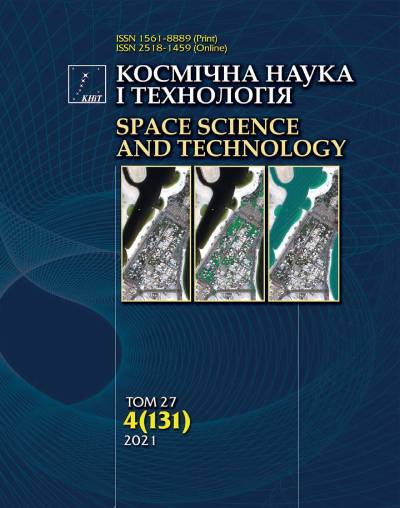Thermal strength of retention compartment interacting with exhaust gas
DOI:
https://doi.org/10.15407/knit2021.04.003Keywords:
heat field, retention compartment, space-rocket complex, thermal strengthAbstract
The thermal strength of the retention compartment is calculated to analyze the possibility of multiple use for a rocket start. The transient heat field of the retention compartment, which is induced by the interaction of the exhaust gas with the retention compartment, is analyzed. The part of the retention compartment undergoes significant heat action with a high-temperature gradient when the rocket is started. This heat action essentially changes in time. This leads to the generation of significant transient stress fields. The aim of the present paper is the calculation of the maximal values of stresses induced by the heat field. We analyze the stress state induced by the steady-state heat field. This field corresponds to the transient heat field at the time when the maximal temperature gradient is observed. The upper bound of stresses in the retention compartment is obtained by the suggested method.
References
Mikheev M. A., Mikheeva I. M. (1977). Heat transfer basics. Moscow: Energia.
Duc N. D. (2016). Nonlinear thermal dynamic analysis of eccentrically stiffened S-FGM circular cylindrical shells surrounded on elastic foundations using the Reddy’s third-order shear deformation shell theory. Eur. J. Mech. A. Solids, 58, 10—30.
https://doi.org/10.1016/j.euromechsol.2016.01.004
Elhefny A., Liang G. (2013). Stress and deformation of rocket gas turbine disc under different loads using finite element modeling. Propulsion and Power Res., 2(1), 38—49.
https://doi.org/10.1016/j.jppr.2013.01.002
Jafari M., Jafari M. (2019). Thermal stress analysis of orthotropic plate containing a rectangular hole using complex variable method. Eur. J. Mech. A. Solids, 73, 212—223.
https://doi.org/10.1016/j.euromechsol.2018.08.001
Perakis N., Haidn O. J. (2019). Inverse heat transfer method applied to capacitively cooled rocket thrust chambers. Int. J. Heat and Mass Transfer., 131, 150—166.
https://doi.org/10.1016/j.ijheatmasstransfer.2018.11.048
Ramanjaneyulu V., Murthy V. B., Mohan R. C., Raju Ch. N. (2018). Analysis of composite rocket motor case using finite element method. Materials Today: Proceedings, 5, 4920—4929.
https://doi.org/10.1016/j.matpr.2017.12.069
Song J., Sun B. (2017). Thermal-structural analysis of regeneratively cooled thrust chamber wall in reusable LOX/Methane rocket engines. Chinese J. Aeronautics, 30(3), 1043—1053.
https://doi.org/10.1016/j.cja.2017.04.007
Trabelsi S., Frikha A., Zghal S., Dammak F. (2019). A modified FSDT-based four nodes finite shell element for thermal buckling analysis of functionally graded plates and cylindrical shells. Eng. Structures, 178, 444—459.
https://doi.org/10.1016/j.engstruct.2018.10.047
Trinh M. C., Kim S. E. (2019). Nonlinear stability of moderately thick functionally graded sandwich shells with double curvature in thermal environment. Aerospace Sci. and Technol., 84, 672—685.
https://doi.org/10.1016/j.ast.2018.09.018
Wang Z., Han Q., Nash D. H., Fan H., Xia L. (2018). Thermal buckling of cylindrical shell with temperature-dependent material properties: Conventional theoretical solution and new numerical method. Mech. Res. Commun., 92, 74—80.
https://doi.org/10.1016/j.mechrescom.2018.07.009
Xu F., Abdelmoula R., Potier-Ferry M. (2017). On the buckling and post-buckling of core-shell cylinders under thermal loading. Int. J. Solids and Struct., 126-127, 17—36.
https://doi.org/10.1016/j.ijsolstr.2017.07.024
Yilmaz N., Vigil F., Height J., Donaldson B., Gill W. (2018). Rocket motor exhaust thermal environment characterization. Meas., 122, 312—319.


